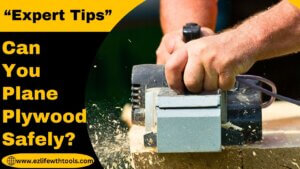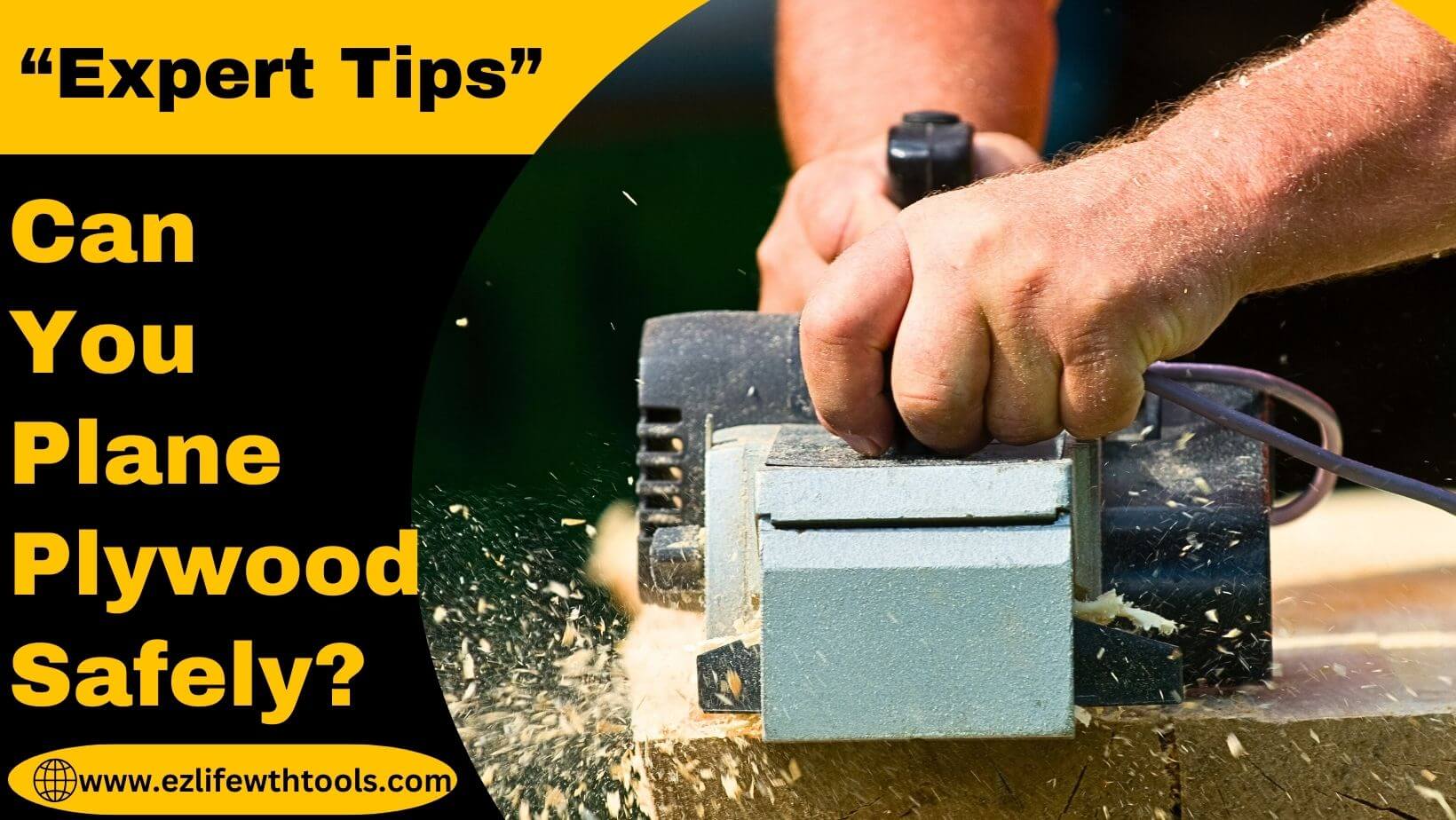Can You Plane Plywood Safely? Expert Tips & Techniques

Plywood consists of thin layers of wood chips glued together to provide versatility and strength.
Achieving accurate dimensions and smooth surface finishes in various projects is a fundamental process in woodworking, which is possible due to the planing process.
The process of planing plywood involves carefully smoothing and refining the surface of the plywood to meet specific thickness requirements, eliminate imperfections, and ensure uniformity.
Using the proper tools and techniques, one can manufacture plywood efficiently, resulting in high-quality, precisely sized, and flawlessly finished lumber for countless construction and crafting endeavors.
In this article, you can learn all the aspects of this process, its advantages and disadvantages, and its alternatives which will make you confident that can you plane plywood or not.
So, keep reading.
Types of Plywood Suitable for Planing
Plywood comes in various types and grades, and each type has different characteristics that affect its plane ability. Higher-grade plywood consists of fewer voids and consistent layers, which is typically easier to plane.
Meanwhile, lower-grade plywood might have voids, knots, or uneven layers, which makes it more challenging to plane effectively.
Factors to Consider when Planing Plywood
Here are some basic factors that should be remembered before performing the process of planing plywood.
- Adhesive: Different types of adhesives are used to bond plywood layers. Some adhesives can gum up planer blades, affecting the smoothness of the surface. If you can understand the adhesive used in the plywood, it will help you anticipate planing challenges.
- Grain Direction: Plywood comprises layers with alternating grain directions. Planing plywood against the grain might cause tear-out or chipping. If you have identified the grain direction and are following the grain direction during the planing, it will minimize the plywood tear-out causes.
- Surface Quality: Pre-existing surface conditions impact the planing. These surfaces consist of nails, splinters or bumps, which require initial treatment before planing to achieve the desired results.
Methods of Planing Plywood
Planing plywood involves different techniques, each with its advantages and considerations. Exploring these methods helps in choosing the most suitable approach for your woodworking project.
Many different techniques can be used to plane the plywood, but each of them has its advantages and considerations.
There are two basic techniques, and we will explain in detail each.
- Hand Planing
- Power Planing
1- Hand Planing
Hand planners are controlled planners but might be more time-consuming compared to power planners. Hand-planing plywood requires skill and precision.
Here are essential tips to plane plywood.
- Sharp Tools: Ensure your hand plane blades are sharp to achieve smoother cuts and avoid tear-out.
- Grain Direction: During the planing process, the direction of the plane should be towards the grain to minimize the chances of tear-out and achieve a cleaner surface.
- Light Passes: Taking light passes gradually rather than heavy cuts helps maintain control and precision, especially with thinner plywood.
- Testing and Adjusting: Periodically check the planed surface for consistency and adjust the plane as needed for uniformity.
Hand planing offers a hands-on approach, allowing for greater control over the wood’s surface, but it might be more time-consuming compared to power planing.
2- Power Planing
Power planers offer efficiency and provide a different level of finesse than hand planing. However, they are ideal for larger projects and quicker material removal.
Power planers, including thickness planers or handheld electric planers, provide efficiency and speed.
- Efficiency: Power planers are faster and more suitable for larger projects, ensuring consistent thickness and smooth surfaces.
- Adjustable Depth: These tools often offer adjustable cutting depths for precision and control.
- Safety Precautions: Proper handling and adherence to safety guidelines are crucial when using power planers.
Alternatives Techniques to Plane Plywood
There is no doubt that planing is a common method for smoothing plywood, but several alternative methods also exist. We will explain three alternative methods of planing.
- Using Sanding
- Using Router
- Using Table Saw
1- Can you Plane Plywood Using Sanding Technique
- Versatility: It is a very safe, easy, versatile method to plane the plywood, even if it can be used in intricate areas. There is no harm in this method.
- Time and Effort: Sanding might be time-consuming, especially for larger projects, and can require significant effort. So, always use this method for only a small amount of material removal. For example, if you want to reduce the 1/2″ thickness and smooth surface, sanding is the best option with the help of a belt sander or drum sander.
- Grit Selection: Choosing the right sandpaper grit is crucial. Coarser grits remove material faster, while finer grits provide smoother finishes. So, always choose between the 150-220 grit sandpaper.
2- Can you Plane Plywood Using Router
It is also the best method to smooth the plywood edges. Routers have shaping bits, which create precise cuts and shaping. But it requires only a setup to fix the piece of plywood firmly.
The smooth surface quality depends on the securely fixed workpiece.
Once you finish all the depth and edge settings, you can start planing the edges according to your needs.
3- Can you Plane Plywood Using Table Saw
Table saws also work the same as routers, but they consist of cutting blades rather than shaping bits.
It also requires object setting according to specifications. Always remember that a table saw requires expertise in handling for optimal results.
The initial setup time can be high, but after setting it up, it is easy to operate. You can use this method for heavy projects.
Comparative Analysis – Planing vs Sanding for Plywood
After reading all the planing techniques, choose the appropriate technique according to your needs.
But first, understand the pros and cons of all techniques for better selection. Because each method also has pros and cons.
Planing Plywood
Pros:
- Planing plywood efficiently removes material, levelling uneven surfaces and achieving uniform thickness.
- When done correctly, planing can result in a smoother finish compared to initial plywood surfaces.
- It’s generally faster in removing larger amounts of material, making it suitable for substantial projects.
Cons:
- Planing plywood against the grain or on problematic surfaces might cause tear-out or chip the plywood.
- Proper tools and expertise are needed for effective planing.
Sanding Plywood
Pros:
- Sanding offers better control, enabling gradual refinement of surfaces, edges, and intricate details.
- It is suitable for various shapes, profiles, and surfaces for intricate finishing.
- Sanding minimizes tear-out when compared to planing.
Cons:
- Sanding can be time-consuming, especially for larger surfaces or substantial material removal.
- Achieving consistent surface smoothness might require extra effort and time.
How to Choose the Right Technique to Plane Plywood
There are many factors to consider before the selection of the right technique for plywood planing.
Here are some important factors to follow.
- Project Considerations: When you are working on a large project that has multiple larger surface areas. In this situation, if you plan all the steps, it can be more proficient. For intricate details or finer finishes, sanding could be the preferable option.
- Combining Techniques: Often, a combination of planing and sanding may yield optimal results. Planing for material removal, followed by meticulous sanding for refined finishing, can achieve excellent outcomes.
- Surface Condition: The initial condition of the plywood surface influences the choice of technique. Smoother surfaces require less aggressive methods, while rougher surfaces may benefit from initial planing.
Additional Tips to Plane Plywood
- Always choose higher-grade plywood with fewer imperfections for smoother planing results.
- Inspect the plywood surface for bumps, knots, or irregularities that may require initial treatment before planing plywood.
- Set up a stable workbench or platform to secure the plywood for safe and effective planing.
- Use measuring tools like a square or ruler to mark accurate cutting lines or dimensions on the plywood surface before planing.
- Ensure proper safety gear, including goggles and gloves, when using power tools like a circular saw.
- Cut along the marked lines with the circular saw, ensuring straight and precise cuts.
- Utilize a router with a suitable bit to shape and refine the edges for a polished look.
- Use clamps to hold the pieces in place.
Conclusion
The art of planing plywood consists of a complicated process. But it can be easy with the help of expertise and proper tool selection.
Understanding plywood’s diverse traits and grain patterns is also paramount in achieving smooth and refined surfaces.
For this purpose, I have explained comparative analysis between planing and alternative methods, which empowers the woodworkers to make informed choices, balancing efficiency and finesse.
While mastering planing techniques requires practice and adaptability, after reading this comprehensive guide, I am confident that you have no doubt that how can you plane plywood safely.
Thank you for your trust and precious time in reading this article.
Best wishes
Frequently Asked Questions
Is it OK to run plywood through a planer?
Yes, you can do it, but while using planer will require some specific techniques due to its composition.
What should you not use a planer for?
Avoid using a planer for non-wood materials, extremely thin stock, or pieces with embedded metal, nails, or other debris to prevent damage.
Can you use a router plane on plywood?
Yes, you can use it on plywood to achieve precise cuts with smooth surfaces, especially it will help for dadoes and grooves.
How do you shave the edge of plywood?
You can shave using a hand plane, router, or a specialty edge-trimming tool for a smooth finishing.
Can MDF be planed?
Yes, it can be planed, but it requires careful handling due to its composition.
How do you make plywood thinner?
You can resaw it using a bandsaw, plane it down with a thickness planer, or sand it.

